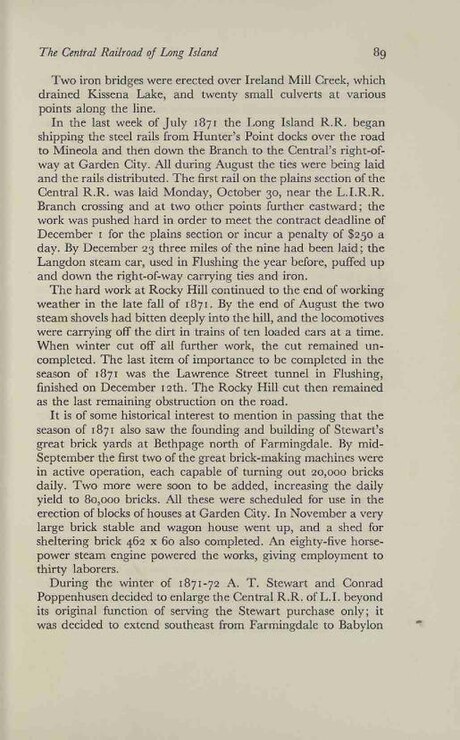Two iron bridges were erected over Ireland Mill Creek, which drained Kissena Lake, and twenty small culverts at various points along the line.
In the last week of July 1871 the Long Island R.R. began shipping the steel rails from Hunter's Point docks over the road to Mineola and then down the Branch to the Central's right-of-way at Garden City. All during August the ties were being laid and the rails distributed. The first rail on the plains section of the Central R.R. was laid Monday, October 30, near the L.I.R.R. Branch crossing and at two other points further eastward; the work was pushed hard in order to meet the contract deadline of December 1 for the plains section or incur a penalty of $250 a day. By December 23 three miles of the nine had been laid; the Langdon steam car, used in Flushing the year before, puffed up and down the right-of-way carrying ties and iron.
The hard work at Rocky Hill continued to the end of working weather in the late fall of 1871. By the end of August the two steam shovels had bitten deeply into the hill, and the locomotives were carrying off the dirt in trains of ten loaded cars at a time. When winter cut off all further work, the cut remained uncompleted. The last item of importance to be completed in the season of 1871 was the Lawrence Street tunnel in Flushing, finished on December 12th. The Rocky Hill cut then remained as the last remaining obstruction on the road.
It is of some historical interest to mention in passing that the season of 1871 also saw the founding and building of Stewart's great brick yards at Bethpage north of Farmingdale. By mid-September the first two of the great brick-making machines were in active operation, each capable of turning out 20,000 bricks daily. Two more were soon to be added, increasing the daily yield to 80,000 bricks. All these were scheduled for use in the erection of blocks of houses at Garden City. In November a very large brick stable and wagon house went up, and a shed for sheltering brick 462 × 60 also completed. An eighty-five horsepower steam engine powered the works, giving employment to thirty laborers.
During the winter of 1871–72 A. T. Stewart and Conrad Poppenhusen decided to enlarge the Central R.R. of L.I. beyond its original function of serving the Stewart purchase only; it was decided to extend southeast from Farmingdale to Babylon
